Imagine if William Alden’s vision, which went a good distance beyond the drawing board, had been realized.
His mid-1950s dual-mode vehicle system proposed electric Self-Transport Road and Rail Cars (Alden staRRcars) that could travel short distances on their own and then merge onto guideway tracks that would provide power and direction for longer travels. You wouldn’t have to wait for a bus or follow a train schedule–you could construct your own timetable.
It was to be a “traveling living room where passengers could watch TV or get news articles via fax machine,” as Adi Robertson writes in the wonderful Verge article “The Road Not Taken.” The piece looks at this cleaner path for the future that never fully materialized. An excerpt:
He kept picking at the idea of an automated transportation network for human beings. He was one of several inventors who had hit on an idea that was known as personal rapid transit, or PRT — a novel and elaborate combination of rail and car.
PRT’s invention is attributed to a transportation expert named Donn Fichter, but the central idea was conceived, remixed, and adapted by many in the 1950s and 1960s. While the details varied, the prototypical PRT system was a network of narrow guideways populated by small passenger pods. When commuters arrived, they would hit a button to select a destination, calling one of the pods like a taxi. Then, instead of running on a set line, the pod would use guideways like a freeway system, routing around stations in order to take passengers directly to their final stop.
The system was designed to be everything that existing public transportation wasn’t. Pods would carry only as many people as an average car, guaranteeing a nearly private ride. Riders wouldn’t need to follow a timetable or wait for other people to enter and exit the system. Because the pods would only be dispatched on demand, cities could run service to many low-traffic areas without worrying about waste. There were no drivers to train or pay, and the pods could run quietly on electrical power instead of with fossil fuels.
The system Alden developed, though, was more than a car-like train — it was literally made of cars. While thinking about his idea in Westborough, MA, he’d met up with a friend who was getting used to a new car commute. It seemed like a perfect example of how public transportation was failing: his friend could have made most of the trip in a train, but he’d have been left stranded (or taxi-bound) when it pulled into the station. Inspired, he added a new feature: his pods wouldn’t just take riders directly to their destination, they would drive right off the track when they got there.•
Tags: Adi Robertson



